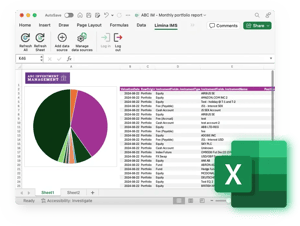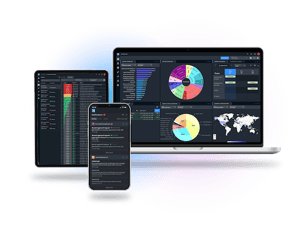
Investment Portfolio Management Software: Guide for Asset Managers
Capabilities of the best investment portfolio management software
This guide outlines the key considerations when comparing the best investment portfolio management tools. Our goal with it, is to give you the information you need to evaluate prospective solutions.
At Limina, we have been clients (investment managers) and know that transparent advice is hard to come by. We appreciate that we might or might not be the best investment portfolio management software for you. In either case, we want you to choose the right system for your specific needs.
If you prefer to watch instead of reading, our founder and CEO, Kristoffer Fürst, walk you through everything you need to know in the video below (if you prefer to read, scroll past the video).
Assumptions to challenge before you start looking for investment portfolio solutions
Before you embark on a selection process, we recommend you pause and consider your ideal solution. What type of software for investment portfolio management is the best fit for you? We use the term here to broadly span “investment management”, i.e. any function capabilities an investment manager needs for their entire investment process.
The illustration below shows the functions an investment portfolio platform could cover, divided into front, middle and back offices. Then, 5 different operating models are illustrated, from a front-to-back system setup to the left to a best-of-breed approach to the right – where portfolio management software (PMS) is a separate system.

Different types of systems can vary dramatically in price. We’ve created a separate guide that walks through cost ranges for investment portfolio management systems.
5 considerations when evaluating investment portfolio management tools
Beyond covering functional areas, investment portfolio management software can have additional capabilities to help your team perform workflows more efficiently (faster) and cost-effectively. We cover 5 such capabilities here:
1. Efficiency
- Exception-based workflows
Exception-based workflows are when the system performs checks (e.g. instrument parameters & prices) and imports data automatically. A team member is notified if anything unexpected happens, such as a file not arriving in time. - Avoiding workarounds
Some systems can be configured in ways to support your processes, without forcing you into workarounds, such as managing some processes in Excel. Look for a flexible system that can fit your workflows, processes and existing ecosystem of solutions and service providers without imposing unnecessary change.
2. Accurate real-time views of data in all areas for all users
The best investment management software can support any type of portfolio view. All transactions go through a lifecycle: market orders, alternative investments or cash transactions. With a state filter, you can view any portfolio in any state. Only two solutions in the market currently support this (Limina is one).
 With an additional toggle for cash specifically – trade date vs settle (value) date – you have the foundation for better investment analysis features.
With an additional toggle for cash specifically – trade date vs settle (value) date – you have the foundation for better investment analysis features.
When planning a portfolio rebalancing, an interactive cash ladder that shows T+1, T+2, and other settlement timings is crucial. For more advanced use cases (including passive portfolios and fund of funds), it’s possible to project exposures into the future (not just cash).
3. Data connectivity & reporting
Even a broad front-to-back investment portfolio platform must connect to other systems and providers. The most common approach is with managed integrations, i.e. when the software supplier builds and maintains connections on your behalf.
This approach works well for standard integrations like trading and market data connections. For most other integrations, such as connecting to fund administrator and custody, the managed connectivity approach has challenges:
- There is a wait time for the supplier to set integrations up (even the “plug and play” ones)
- There is usually a cost per integration
- You’re limited to the integrations that the supplier has to offer. Even if the provider has hundreds of pre-built connections, it usually doesn’t cover all your needs. For example, there can be tens of possible connections to just one custodian.
A better approach is a user-configurable import/export application. An import/export app allows users to configure new integrations in 3-5 minutes. It’s free of charge, eliminates the wait time and will enable you to connect to any source (in and out) instantly.
4. Excel plug-in
Most portfolio managers use Excel even when their platform has flexible portfolio tracking capabilities. At Limina, we accept and embrace this fact, instead of trying to fight it. Which is why we’ve created a native Excel plug-in.
The plug-in helps managers reduce the number of formulas and tabs used in spreadsheets to “manage data”. Readily usable data is pulled into the spreadsheet live. Want to see it in action? Book a demo today!

5. The best investment portfolio software is frictionless to use [cloud & access from anywhere]
Modern cloud investment portfolio management software provides users with secure access from anywhere. Portfolio managers get a mobile app for portfolio tracking. When working from home, there is no need for VPN or remote desktop solutions to ensure security.

2 soft questions to ask when comparing portfolio management systems
It’s not just the functionality of the portfolio investment management platform that matters when selecting a vendor. You’ll want to ensure the vendor is a good fit for you as a client today and in the future. Here are some ways to ensure that.
1. Is the vendor a true partner? How to find out
Most vendors will claim to want “partnerships” with their clients, so how do you find the truth? A good check is whether the supplier publishes their pricing on their website.
It might sound strange, but you want a vendor to be transparent, right? And you want to know their pricing before you speak with sales and sit through a demo?
The vendor knows their pricing, so if they are genuinely client-centric and focused on YOU – they will have pricing transparent on their website. Check out Limina’s pricing here.
2. Are you a typical client?
Are most clients of the investment portfolio management solution you’re considering, similar to you? For example;
- Are they the same type of firm (asset manager, asset owner, OCIO, hedge fund, etc) as you?
- Do the other clients invest in asset classes similar to yours?
- And do they have a similar investment approach (passive, active)?
The more clients that are similar to you, the more the suppliers’ roadmap will focus on functionality that is likely to benefit you.
For more tips and tricks, follow our founder and CEO, Kristoffer Fürst, on LinkedIn.
Trends to Take into Account
There is a current trend towards external service providers taking on parts of the workflows in the investment management industry. This outsourcing trend includes trading, which can range anywhere from complete outsourcing to supporting your trading team during certain times of day, e.g. Asian trading hours if you’re based in Europe or North America.
Having a solution that directly connects to such providers and sends you feedback in real-time is essential. With the proper PMS containing investment data management capabilities, you can set alarms to get emails if unexpected events happen.
The outsourcing trend of the past decade continues, and more firms are looking to outsource their operations. Regardless of your model today, it’s good if the investment portfolio management software you choose can support both models. That allows you to outsource or insource in the future without undertaking a system change.
Limina offers Data Management as a Service.
Despite the rise of artificial intelligence and machine learning over the last few years, applications within the investment management workflows have been limited. There are a few reasons why:
- AI and ML are statistical models that “make mistakes”, and investment management workflows must be precise. For example, an instruction like “rebalance to benchmark” must always be done correctly.
- AI, in particular, has a few seconds delay in processing. For example, a parameter autocomplete will be slower than front office users filling out the info they know.
Some use cases will work, for example, AI suggesting configuration of autocomplete rules and data quality checks.
Regional Investment Portfolio Management Software (Canada, UK, etc)
Beyond the global leaders of investment portfolio management software, there are choices that are more popular in certain regions of the world:
- Canada: There is a national provider (Infinite Investment Systems: Harmony) but it seems to be selected mostly by cost sensitive firms (according to online research, I/we have no first hand experience with this provider), not for having functionality required to support Canadian investment managers specifically.
- UK: While the United Kingdom is Europe's financial centre, and not part of EU anymore, 2 solutions are have broader adoption here than their global average: Thinkfolio (originally developed in the United Kingdom, now owned by American S&P) and Limina (Swedish HQ:d).
- France: JUMP is a french provider that was acquired by Clearwater a few years back, and who mostly services French clients. Clearwater has subsequently acquired much larger global player Enfusion, making the future of JUMP uncertain.
- Switzerland: There is still a preference by Swiss firms to have data stored within the country, something that few global cloud providers can achieve (Limina can, reach out and we'll tell you more). For this reason, local providers have a stronger position than in most other countries.
- Australia: home to IRESS, so there is a slight bias towards there solutions for the same reason that the UK have a tilt towards European investment portfolio management systems.
- Scandinavia: Limina and SimCorp have a strong position, thanks to their headquarters being in this region.
Regardless of region, the global trend from Canada, through Europe, to APAC, is clear: towards all-in-one investment management platforms that cover workflows from the front office all the way to, and through, operations. Clients prefer solutions built with a single source of truth (one database, not a patchwork of systems/acquisitions) which is why providers like Limina are seeing success.
Summary: the best software to manage investment portfolios
An aspect we haven’t touched upon, which is essential, is to ensure any portfolio investment management software you work with supports the asset classes you need. Whether you’re trading equities, fixed income, funds, derivatives, alternatives, etc, your system must support them.
Finally, to recap what we’ve covered in this article:- Consider if you’d ideally want a best-of-breed setup or an investment portfolio management system that supports all (or most) functional areas
- Consider the cost of different solutions
- Explore how well the solution covers your requirements, beyond the functional box ticking exercise - such as:
- Efficient and exception-based workflows
- Flexible real-time views of portfolios
- Data connectivity and reporting
- Excel plug-in
- Access from anywhere
- Can the vendor prove they take a partner approach, and are you a typical client of theirs?
Explore a better investment portfolio management system
See how Limina can help you increase efficiency and control costs.







